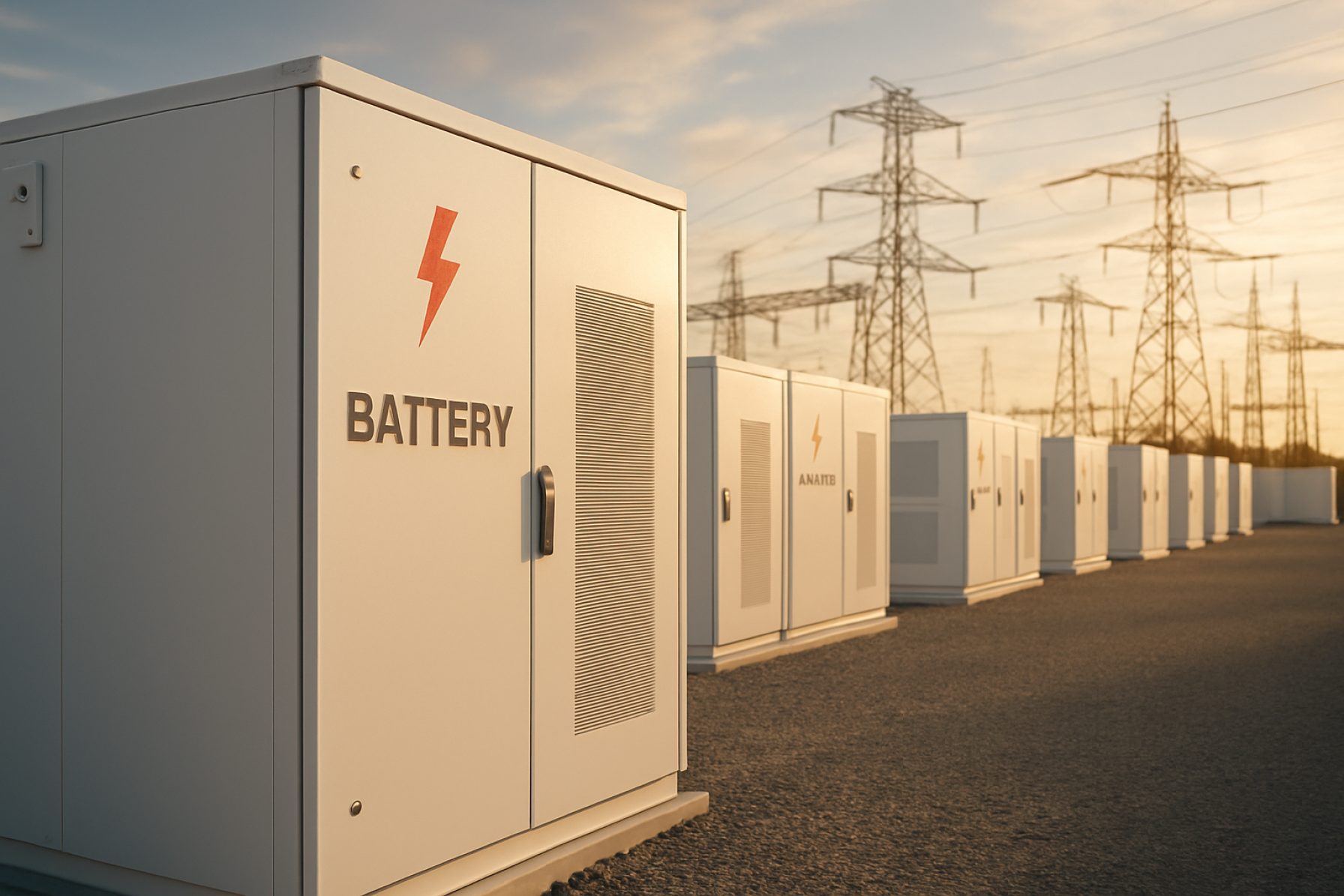- Repurposed EV battery storage systems, like the MegaMAX series, provide fast, modular solutions to grid instability caused by renewables.
- These commercial batteries combine lithium-iron-phosphate and nickel-manganese-cobalt chemistries, offering rapid AI-driven response to frequency fluctuations.
- Plug-and-play design enables deployment in under two minutes, supporting cities during power outages and blackouts.
- Using second-life car batteries lowers each unit’s carbon footprint by over 40%, saving up to 100 tons of CO₂ equivalent.
- Hybrid systems reduce industrial energy costs by up to 50%, while generating revenue through grid flexibility markets.
- MegaMAX units operate reliably in harsh conditions, enhancing both resilience and sustainability as key priorities for future energy systems.
Thunder rolls over a cityscape, and lights flicker as the grid teeters on the edge. But a new breed of battery storage, rising quietly from the UK, could steady that precarious balance in an instant—remaking not just how we store energy, but how we survive the darkness.
A British innovator has unleashed massive commercial battery systems built not from scratch, but from the bones of yesterday’s electric vehicles. In gleaming industrial containers, up to 18 repurposed EV battery packs with both lithium-iron-phosphate and nickel-manganese-cobalt chemistries are stacked together, forming the backbone of an energy safety net. With a click and a whisper, these batteries spring to life, thanks to millisecond-fast AI controls and a modular design that slots into place in less than two minutes.
The visuals are striking: imagine a 12-ton behemoth, roughly the length of a city bus, being rolled off a standard truck and plugged into an urban grid under threat—a new first response to old vulnerabilities. This is the MegaMAX series, with units named MAX1000 and MAX1500, built to absorb shocks from frequency fluctuations that continue to plague renewables-powered grids. Grid inertia, once provided only by spinning turbines, now has a digital, battery-powered twin—synthetic, but just as real and even faster.
While Europe wrestles with the growing pains of the energy transition—blackouts in Spain and Portugal, fires flickering through crucial substations in London—the fragility of power systems has never felt more immediate. Traditional power plants, with their natural inertia, are fading into obsolescence. Renewables bring cleaner air, but pose new technical riddles, particularly in maintaining the magic 50Hz frequency that keeps a nation’s lights on.
Yet, in MegaMAX, cities may have found their failsafe. The hybrid design isn’t just about resilience. By giving a second, profitable life to car batteries, it hacks away over 40% of the embedded carbon footprint per unit—saving as much as 100 tons of CO₂ equivalent. It’s a potent demonstration of how circular thinking can bind climate action to business sense, providing up to 50% lower energy costs for industries and injecting fresh revenue streams via grid flexibility markets.
Durable enough to handle temperatures from arctic blasts to summer scorchers—working flawlessly between -10° C and 40° C, shrugging off humidity and rain with industrial-grade protection—the units are built for real-world abuse.
The urgency couldn’t be clearer. Cities need energy security as much as clean power. As blackouts and brownouts become more than distant headlines, the lesson is unmistakable: innovation must deliver not just progress, but protection.
At the heart of this evolution lies a simple but crucial realization: the energy systems of the future must be flexible, fast, and fundamentally sustainable. Solutions like MegaMAX reveal how yesterday’s technology—repurposed, reimagined—can power tomorrow’s world.
For more on breakthroughs shaping urban life, visit NYT or delve into the latest energy news from BBC.
Key takeaway: As our cities and industries teeter between ambition and risk, the next generation of battery storage shows that resilience and sustainability can go hand in hand—lighting the way through the storms ahead.
This $ave the Grid: How Second-Life EV Batteries Are Quietly Revolutionizing Urban Power Security (You Won’t Believe What Happens Next!)
# MegaMAX: The New Battery Giants Quietly Saving UK Cities from Blackouts
The future of energy storage is no longer just a vision — it’s arriving now, inside city blocks and industrial estates across the UK. MegaMAX, a breakthrough commercial battery system built from repurposed electric vehicle (EV) batteries, is setting a new global standard for how cities achieve resilience, cut carbon emissions, and drive down power bills — all at a pace and scale previously thought impossible.
What the Article Didn’t Tell You: Essential MegaMAX Facts & Insights
1. How Exactly Does EV Battery Repurposing Work?
– EV battery repurposing involves salvaging batteries from end-of-life electric cars (often when battery capacity drops to ~80% for driving but remains viable for stationary use).
– Batteries pass rigorous testing for health, capacity, and safety before integration into stationary storage.
– According to the International Energy Agency (IEA), up to 95% of EV batteries can be repurposed—extending usable battery life by an extra 7-10 years ([source](https://www.iea.org)).
2. Why Millisecond-Scale AI Controls Are a Game Changer
– Grid balancing often requires extremely fast responses — conventional gas peaker plants can take minutes to react, while MegaMAX’s AI-driven system responds in milliseconds.
– Immediate response helps maintain critical grid frequency (e.g., 50Hz in Europe), reducing the likelihood of cascading blackouts ([Grid-Frequency Case Study](https://www.nationalgrid.com)).
– AI optimises when to charge, discharge, or participate in flexibility markets — maximising both utility and profit.
3. Comparative Specs: MegaMAX vs. Industry Peers
| Feature | MegaMAX | Tesla Megapack | Fluence Q-Pulse |
|————————|—————————|———————|———————|
| Chemistry | LFP + NMC (hybrid) | LFP | LFP |
| Sizing | 1–1.5 MWh/container | 3.9 MWh/container | Custom modular |
| Install Time | <2 min (modular plug-in) | ~1 hour | Varies |
| Source of Cells | Second-life EV batteries | New build | New build |
| Operating Range | -10° C to 40° C | -20° C to 50° C | -25° C to 40° C |
| CO2e Savings | Up to 100 tons/unit | Varies | Varies |
| Pricing | Estimated 30–50% lower | Higher upfront | Varies |
4. Real-World Use Cases & Life Hacks
Use Cases
– Emergency backup for hospitals, transport hubs, or data centers during grid failure.
– Storing surplus wind/solar power and selling it back to the grid (grid arbitrage).
– Powering city infrastructure during peak demand, reducing strain and blackout risk.
– Supporting microgrids in remote or disaster-prone regions.
How-To Steps: Deploying MegaMAX
1. Assess your facility’s peak demand and local grid fragility.
2. Contact the MegaMAX provider for a technical audit.
3. Plan for modular unit delivery — needs only standard truck access and basic concrete pad.
4. Plug in to facility or grid — software configures automatically, up and running in 2 minutes!
5. Industry Trends & Market Forecasts
– The global stationary battery market is projected to hit $120 billion by 2030, with second-life batteries making up 23–30% of installations in urban settings ([IEA, 2023]).
– Leading energy consultancy Wood Mackenzie predicts a six-fold increase in grid-scale second-life battery deployments within the next five years, mostly in Europe and Asia.
6. Reviews, Pros & Cons Overview
Pros:
– Substantial CO₂ emissions reduction compared to both new batteries and fossil peaker plants.
– Economic savings for industry: operational costs cut up to 50% with grid flexibility revenues.
– Super-fast deployment and minimal on-site disruption.
Cons and Limitations:
– Dependence on consistent supply of used EV batteries — potential bottleneck as vehicles age out over time.
– End-of-second-life issue: even repurposed batteries eventually require recycling, though this market is rapidly growing ([World Economic Forum](https://www.weforum.org)).
– Battery chemistries (NMC vs. LFP) have different safety, lifetime, and recycling profiles — hybrid approach needs careful management.
7. Security, Sustainability & Compatibility
– All MegaMAX units use industrial-grade fire suppression, water ingress protection (IP65+), and real-time thermal/cell health monitoring — essential given the potential fire risk with Li-ion batteries.
– Modular containers are built for plug-and-play upgrades — adding capacity as your city or company grows.
– Full compatibility with wind, solar, and traditional grids; software links with utility control centers via standard communication protocols (e.g., DNP3, IEC61850).
8. Controversies & Debates
– Some critics point out that while re-use extends battery life, safe disposal or recycling after 'second life' is not always guaranteed — robust regulatory oversight is essential ([Reuters](https://www.reuters.com)).
– Market still awaits standardized certifications for second-life battery safety and performance (ongoing work by EU & UK regulators as of 2024).
Top Reader Questions, Answered
Q. Will using second-life batteries harm my city’s safety or reliability?
A: When properly tested and integrated, these batteries perform as well as new cells in stationary roles, often under more benign conditions than in a moving car.
Q. Are these systems prone to fires, like some headlines warn?
A: MegaMAX deploys multiple layers of fire detection, suppression, and remote monitoring—making the risk extremely low compared to legacy battery systems.
Q. How much money can a city or business actually save?
A: Cities and industrial users see up to 50% lower energy bills in side-by-side trials; revenues from grid balancing markets further boost ROI.
Q. Is this a scalable solution, or a niche fix?
A: The approach is highly scalable: as global EV adoption surges, second-life battery supply will mushroom—potentially supplying dozens of gigawatt-hours of storage annually.
Actionable Recommendations & Quick Tips
– If you operate a critical infrastructure, evaluate second-life storage as a rapid, cost-effective insurance policy against blackouts.
– For municipalities: leverage government grants or incentives for energy resiliency and carbon reduction by piloting modular battery projects.
– Businesses can join local grid flexibility markets—turning a backup battery into a new revenue stream!
– Keep track of regulatory changes around battery recycling to ensure long-term compliance.
Final Word
Repurposed EV battery storage—typified by the MegaMAX series—marks the dawn of a new energy era: one where yesterday’s technology safeguards tomorrow’s cities, blending sustainability, resilience, and real-world savings. As urban power infrastructure faces mounting challenges and climate goals, the practical, proven approach of second-life batteries may just be the failsafe we've all been waiting for.
Stay updated on global innovations at the intersection of tech and sustainability on NYT or with the latest coverage from BBC.









